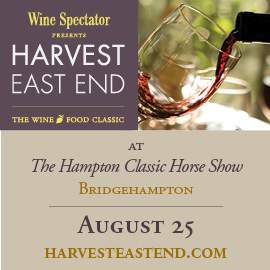Tasting Vintage Variation — A Flight of “Flight”
You can buy bottle after bottle of mass-produced,
ubiquitous wines like Yellowtail Shiraz or Cavit Pinot Grigio without
even looking at the year on the label. That’s because year-to-year
variation is barely perceptible in those wines. Huge vineyards, huge
production and blending options that lead to a “house style” all result
in fairly consistent flavors year in and year out.
That’s boring and lame if you
ask me.
That sort of cookie-cutter consistency is not the case here on Long
Island, where even the largest vineyards are miniscule by world
standards. And, with generally cool weather that changes considerably
from one year to the next, local producers are really at the mercy of
Mother Nature.
And so are your taste buds — because no matter how good a winemaker is,
it all begins with the fruit. As the saying goes, “Garbage in. Garbage
out.”
Some of our region’s best years have 1995, 2001 and 2005. Reds from the
2005 vintage haven’t been released yet and won’t be for another couple
years — but don’t miss them. I’ve tasted several in barrel and the
intensity and depth are unlike any Long Island wines I’ve tasted.
Of course, bad wine can still be made in even the best years — and good
wine can be made in less-than-optimal years as well partially because
Long Island has so many unique micro-climates. One vineyard can get
several inches of rain the same day that one just up the road doesn’t
get a drop. And, unfortunately, an overzealous or over-manipulating
winemaker can destroy the beauty and quality of perfect grapes.
The best way to see vintage differences yourself is by tasting the same
wine, from the same winery, through at least a few vintages, side by
side by side.
Without a deep wine cellar, and the patience to hold onto older
vintages, this can be difficult to accomplish. But one winery on the
North Fork is making it a little bit easier.
Osprey’s Dominion Vineyards in Peconic is offering three consecutive
vintages — 2000, 2001 and 2002 — of its “Flight” Meritage red blend in
gift-worthy three packs. This flight of “Flight” is $99 — not cheap,
but chip in with a few friends, share the cost and learn a little about
Long Island’s recent vintage history.
Osprey’s Dominion’s 2000 Flight ($35 when purchased separately) has an
aromatic nose that offers blackberries, light oak toastiness, and
subtle fresh herbs. This blend of merlot and cabernet sauvignon is
fruit forward and elegant with flavors — blackberry, black cherry,
smoky oak, and herbs — that are balanced nicely by ripe, medium grip
tannins. The finish is lengthy and offers a little eucalyptus at the
very end.
The ripeness of the 2001 vintage comes through with more intensity and
less nuance in winemaker Adam Suprenant’s 2001 Flight ($35). On the
nose, intense blackberry and blueberry are accented by herbs, tomato
leaves and subtle wet soil earthiness. This wine displays a similar
profile on a rounder, fuller-flavored palate, with ripe,
well-integrated tannins, and a little acidity.
Much more similar to the 2000, Osprey’s Dominion’s 2002 (N/A) hasn’t
been released on its own yet. Straightforward blackberry aromas and
noticeably less oak character mark the nose. The palate is youthful
with bright fruit and slightly astringent tannins and acidity. This one
isn’t quite ready for drinking yet, but that makes this flight of
“Flight” all the more educational — you can taste similar wines in
different stages of development.
Of the three, my favorite is the 2000 for its refined style and balance. Visit www.ospreysdominion.com or call 765-1903 and find out which you prefer.

















Wow - great descriptions. I noticed something here that I am seeing elsewhere: the vintages that then press says are the best (the 2001 in this case, according to your post) don’t always show as well as the surrounding vintages. I like the 01 burgundies better than the 02s so far, and same for Oregon pinots. Yet in both cases, the 02 were trumpeted by the press. I can’t figure out why this would be…
Neil…
I think “best vintages” is really about the region and vintage overall…so overall quality is best in those years. But, that doesn’t mean that good (and sometimes even great) wines are made outside of the “best” years.
In the case of these wines…2000 is actually known as a good year for reds..but 2001 was good overall for all wines.
I feel stupid asking this, but is the blend ratio in that wine always 60/40 Merlot to Cab. S? I would assume it has to be otherwise the year to year variations might be masked by variations in the blend.